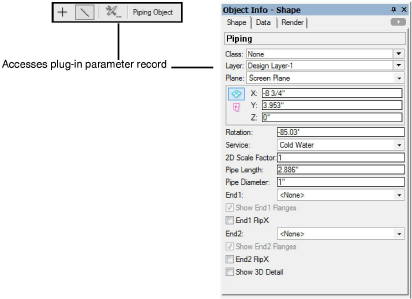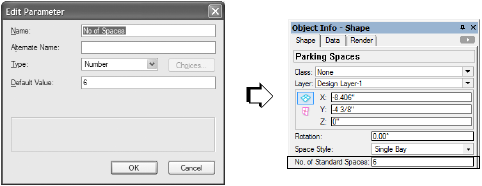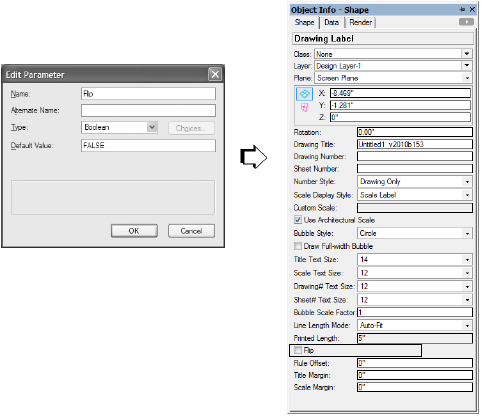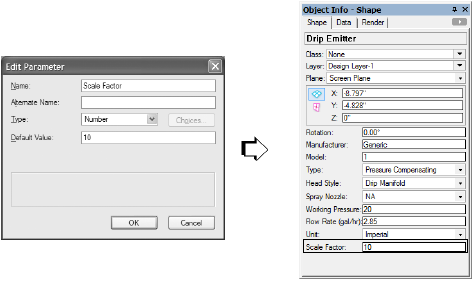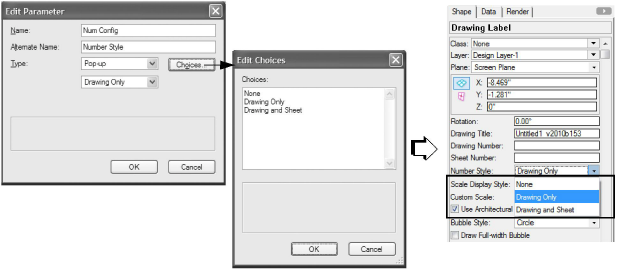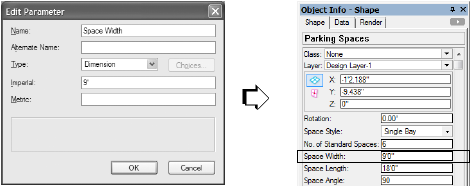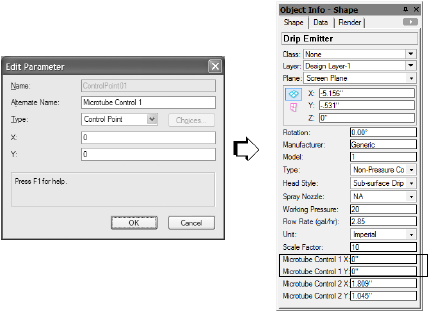VS:Plug-in Parameter Types
.VectorScript|VectorScript ..VS:Function Reference|Function Reference ..VS:Function_Reference_Appendix|Appendix
Scripted plug‐in objects allow scripts to be directly integrated into a Vectorworks workspace and be made available to any Vectorworks file. The three types of plug‐ins—menu commands (.vsm), tools (.vst), and objects (.vso) — allow scripts to integrate into both workspace menus and tool palettes, as well as other Vectorworks program features such as the Resource Browser.
When custom plug‐ins are created through scripting, plug‐in parameter values define plug‐in objects and store persistent values associated with all types of plug‐ins. This section describes the types of parameters and their usage.
How Parameters Work
Plug‐in parameters are stored in a parameter record, which is a specialized type of Vectorworks record format. Parameter records are required by scripted objects, but they can be created and associated with any type of plug‐in.
Values are stored in the parameter record by means of parameter fields. These fields act like regular record fields and can be accessed for reading and writing by the plug‐in script. Parameter fields have distinct data types for storing different kinds of information; information on specific parameter types is found later in this section.
The values stored in the parameter record of a scripted plug‐in can be used in one of several ways. Objects use the stored parameter values to define and create the appearance of the object instance. Menu commands and tools use parameter records to store information for subsequent use with the plug‐in item. Switching files displays stored values associated with the new file, or, if no parameter record exists, will display the default values of the parameter record as created by the plug‐in item.
Parameter records can be associated with the plug‐in item itself, or, in the case of objects, can be associated with each instance of an object placed in a file. When an object instance is placed in the file, the object’s parameter record can be edited using the Object Info palette. (The Object Info palette also provides a convenient interface for editing the definition path for path objects.)
Parameter Types
Scripting provides several parameter field types for use with plug‐ins:
- Integer
- Boolean
- Number
- Text
- Popup
- Radio Button
- Dimension
- X‐Coordinate
- Y‐Coordinate
- Control Point
- Static Text
- Classes Pop‐up
Parameter records can have multiple parameter fields of the same type, or combinations of parameter fields of different types. The following sections document each parameter type in detail.
Integer
Integer parameters store a single INTEGER data value.
An integer parameter value is displayed in the Object Info palette in an editable field, and can be edited as desired. Integer parameter fields support calculations in the field, fractional values entered into an integer parameter field will be rounded to the nearest value.
Integer parameters do not support unit marks or unit conversion.
Boolean
Boolean parameters store a single BOOLEAN data value.
A boolean parameter is displayed in the Object Info palette as a check box, with the state of the check box indicating the TRUE-FALSE state of the value (TRUE = checked, FALSE = unchecked).
Boolean parameters do not support unit marks or unit conversion.
Number
Number parameters store a single REAL data value.
A number parameter value is displayed in the Object Info palette in an editable field, and can be edited as desired. Number parameter fields support calculations in the field, and fractional values entered into a number parameter field will be displayed using the current units fractional display setting.
Number parameters do support unit marks or unit conversion.
Text
Text parameters store a single string data value. The stored value may be up to 255 characters in length.
A text parameter value is displayed in the Object Info palette in an editable field, and can be edited as desired.
Popup
Popup parameters store a single STRING data value that is selected from a predefined list of values. The list of available values is defined in the parameter definition dialog box, and cannot be modified during script execution.
Popup parameter values are displayed in the Object Info palette as popup menu listing the defined value options. The active parameter value (the value which is stored in the parameter) is indicated by the value displayed in the popup when the control is not selected, and by a bullet next to the item when the control is selected. To modify the value, select the desired parameter value from the popup control.
Radio Button
Radio button parameters store a single STRING data value that is selected from a predefined list of values. The list of available values is defined in the parameter definition dialog box, and cannot be modified during script execution.
Radio button parameter values are displayed in the Object Info palette as a series of radio buttons in a group box, with one radio button for each defined value. The active parameter value (which is stored in the parameter) is indicated by the selected radio button. To modify the value, select the radio button corresponding to the desired value.
Dimension
Dimension parameters store a dimension data value as a REAL numeric value.
A dimension parameter value is displayed in the Object Info palette in an editable field, and the value can be edited as desired. Dimension parameter fields support calculations in the field, and fractional values entered into a dimension parameter field will be displayed using the current unit’s fractional display setting.
Two default values can be specified—one for Imperial units, and one for Metric. The appropriate dimension is automatically displayed for the plug‐in depending on the file’s units setting. Entering two default values is not required; if one default is left blank, the other value is converted to the appropriate value for the units in the file.
- Plug‐ins from versions of Vectorworks earlier than 12 are automatically saved with the dual default value
- capability when the plug‐in is edited. The single existing default dimension, if it has a unit, is automatically
- saved in the appropriate default value field (Imperial or Metric).
Dimension parameters support the use of unit markers with values; values stored in one unit format are automatically converted to an equivalent value if the document unit setting is modified. Units are not required; values without units assume the drawing units and are not converted.
Dimension parameters are not sensitive to changes in the user origin of a document.
X-Coordinate
X‐coordinate parameters store a coordinate data value as a REAL numeric value.
A coordinate parameter value is displayed in the Object Info palette in an editable field; the value can be edited as desired. Coordinate parameter fields support calculations in the field, and fractional values entered into a coordinate parameter field will be displayed using the current unit’s fractional display setting.
Coordinate parameters support the use of unit marks with values; values stored in one unit format will be automatically converted to an equivalent value if the document unit setting is modified.
Coordinate parameters are sensitive to changes in the user origin of a document, and are designed to be used with geometric data that is related directly to locations within a Vectorworks document. Values displayed in coordinate fields will be corrected for any changes in the document user origin.
Y-Coordinate
Y‐coordinate parameters store a coordinate data value as a REAL numeric value.
A coordinate parameter value is displayed in the Object Info palette in an editable field; the value can be edited as desired. Coordinate parameter fields support calculations in the field, and fractional values entered into a coordinate parameter field will be displayed using the current unit’s fractional display setting.
Coordinate parameters support the use of unit marks with values; values stored in one unit format will be automatically converted to an equivalent value if the document unit setting is modified.
Coordinate parameters are sensitive to changes in the user origin of a document, and are designed to be used with geometric data that is related directly to locations within a Vectorworks document. Values displayed in coordinate fields will be corrected for any changes in the document user origin.
Control Points
Control point parameters are a specialized parameter type designed to create control points in plug‐in objects. A control point is similar to a selection handle and allows the user to click and drag to reshape the object. When created, a control point parameter consists of two linked coordinate parameters. The two parameters correspond to x‐ and y‐coordinate fields for the control point.
Control point parameter fields usually display as control labels in the Properties dialog box of an object when it is created for the first time. Control point fields are normally hidden in the Object Info palette. When the parameters display, they are a pair of editable coordinate fields; the values can be edited as desired. Control points, like coordinate fields, support calculations in the fields. Fractional values entered into a control point parameter field will be displayed using the current unit’s fractional display setting.
Control point parameters support the use of unit marks with values; values stored in one unit format will be automatically converted to an equivalent value if the document unit setting is modified. Control point parameters are sensitive to changes in the user origin of a document, and values displayed in the field will be corrected for any changes in the document user origin.
Control point fields can be renamed by entering a display name in the alternate name field of the parameter. When referring to the parameter in a script, use the actual definition name of the parameter.
Static Text
Static text parameters are used to display information on the Object Info palette. The information is for display purposes, and cannot be edited by the user. This type of parameter might display a calculated field, like the area or volume of an object, or some other property. Each instance of the object in a drawing can display a different value for this parameter.
Classes Pop-up
Allows the user to select a class from a pop‐up of available classes.
Accessing Parameters from Scripts
Scripting provides a well‐defined mechanism for directly accessing values in parameter records within plug‐in scripts. This mechanism, known as parameter referencing, allows parameter values to be easily retrieved for use with scripts.
The generalized syntax for parameter references is as follows:
P<name of parameter>
Parameter names should contain underscores representing any embedded spaces in the parameter name. For example, a dimension parameter named Space Width would be referenced in a script as:
PSPACE_WIDTH
Parameter references can be used to assign values to other identifiers in a script. Supported identifiers include variable, array, array element, and structure member identifiers. For example, assigning the value in the parameter to a variable would be defined as:
sp_width:= PSPACE_WIDTH;
Parameter references can also be used like constants in expressions or function arguments. For example, valid uses of Space Width parameter would include:
totalWidth:= 5 * PSPACE_WIDTH; CalculateTotal(PSPACE_WIDTH,2);
Parameter references should always be treated as constant values. Parameter references do not accept value assignments, and parameter reference values cannot be modified.
Setting Parameter Values from Scripts
Scripting uses the SetRField() function to write values to parameter records. Scripting also provides two functions, GetCustomObjectInfo() and GetPluginInfo() which return the information needed by SetRField() to write values to parameter records.
Using GetCustomObjectInfo() or GetPluginInfo() with SetRField() is relatively straightforward. When writing a value back to the parameter record of an object instance, first use GetCustomObjectInfo() to obtain information about the object. Once this information has been retrieved, it can be used in conjunction with SetRField() to write the value back to the parameter record. The following example illustrates this technique:
BEGIN resultStatus:= GetCustomObjectInfo(objName,objHd,recHd,wallHd); IF resultStatus THEN BEGIN sp_width:= PSPACE_WIDTH; ... ... sp_width:= 5 * sp_width; ... ... SetRField(objHd,GetName(recHd),’Space Width’, Num2StrF(sp_width)); END; END;
In the example, GetCustomObjectInfo() is called to obtain the name of the object and a handle to both the object instance and its associated parameter record. This information is then used with SetRField() to write the value to the parameter record field.
Note that when writing values to the parameter record, the actual name of the field, not the parameter reference, is used. Parameter references should only be used for retrieving data from the parameter record.
The example also points out one additional requirement for using SetRField(). In the example, the value in sp_width is a REAL, but SetRField() requires a STRING argument for the value being assigned to the record field.
In this case, it will be necessary to convert the dimension value to a STRING for compatibility with the function call. The parameter record will convert the value back to the appropriate data type when it is stored.
The method for writing values to the parameter records of menu commands and tool items is almost identical to the method used for objects. In the case of menu commands and tool items, the function GetPluginInfo() should be used to obtain the plug‐in name and a handle to the parameter record. The example below illustrates how the function is used with a menu command:
BEGIN ... ... IF GetPluginInfo(cmdName,pRecHd) THEN offvalue:= GetField(5); numlines:= GetField(6); cmdHd:= GetObject(cmdName); SetRField(cmdHd,GetName(pRecHd),'Offset',Num2StrF(offvalue)); SetRField(cmdHd,GetName(pRecHd),'Lines',Num2Str(0,numLines)); END; ... ... END;
In the example, GetPluginInfo() is used to obtain the name of the menu command and a handle to the parameter record. This information is used with SetRField() to write values to the parameter record of the menu command.
Parameter records for menu commands and tool items are very useful for storing information between uses of the command or tool item. For example, if a user modifies the default settings of a tool item, this information can be stored and reused on subsequent uses of the tool.
- Like objects, records for menu commands and tool items are stored with a Vectorworks file; switching files may
- cause the default settings for a command or tool item to change.
Setting Parameter Visibility
By default, all plug‐in parameter users interface controls are enabled and visible. This behavior may be overridden using SetParameterVisibility() and EnableParameter(). Using GetCustomObjectInfo() or GetPluginInfo() with these procedures is relatively straightforward. First, use GetCustomObjectInfo() to obtain information about the object. Once this information has been retrieved, the plug‐in parameter’s user interface attributes can be specified. In each case, the parameter argument is the universal name of the plug‐in’s parameter. For example:
BEGIN
...
resultsStatus := GetCustomObjectInfo(objName,objHd,recHd,wallHD);
IF resultStatus THEN BEGIN
EnableParamter(objHD, ‘Space Width’. FALSE);
{Disables the control for the Space Width parameter}
SetParameterVisibility(objHd, ‘Space Depth’. FALSE);
{Hides the control from the Space Width parameter}
...
END;
END;
Like the plug‐in object example above, plug‐in menus and tools that use parameters can use SetParameterVisibility() and EnableParameter().
BEGIN ... ... IF GetPluginInfo(cmdName,pRecHd) THEN cmdHd:= GetObject(cmdName); EnableParameter(objHd, ‘Offset’. FALSE); SetParameterVisibility(objHd, ‘Lines’. FALSE); END; ... ... END;
Setting Default Parameter Visibility
Additionally, default parameter visibility may be set for objects, menus, and tools in the Plug‐in Editor/Edit Parameter dialog box. By placing two leading underline characters as a prefix to the parameter’s universal name, the parameter visibility is set to false. Using this technique hides a parameter in the default settings dialog box for a plug‐in. Parameters with this special universal name prefix will not be shown unless explicitly made visible using SetParameterVisibility.
